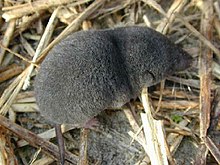Formerly used suborder of mammals
Soricomorpha[1] Temporal range:
Early Paleocene–Recent
PreꞒ
Ꞓ
O
S
D
C
P
T
J
K
Pg
N
Southern short-tailed shrew
Scientific classification
Kingdom:
Animalia
Phylum:
Chordata
Class:
Mammalia
Order:
Eulipotyphla
Suborder:
Soricomorpha Gregory 1910[2]
Families
Soricomorpha (from Greek "shrew-form") is a formerly used taxon within the class of mammals . In the past it formed a significant group within the former order Insectivora . However, Insectivora was shown to be polyphyletic and various new orders were split off from it, including Afrosoricida (tenrecs , golden moles , otter shrews ), Macroscelidea (elephant shrews), and Erinaceomorpha (hedgehogs and gymnures ), with the four remaining extant and recent families of Soricomorpha shown here then being treated as a separate order. Insectivora was left empty and disbanded.[1]
Subsequently, Soricomorpha itself was shown to be paraphyletic , because Soricidae shared a more recent common ancestor with Erinaceidae than with other soricomorphs.[3] Eulipotyphla [4]
Living members of the group range in size from the Etruscan shrew , at about 3.5 cm and 2 grams, to the Cuban solenodon , at about 32 cm and 1 kg.
Soricomorpha
Family Soricidae (shrews)
Subfamily Crocidurinae : (white-toothed shrews)
Subfamily Soricinae : (red-toothed shrews)
Subfamily Myosoricinae : (African white-toothed shrews) Family Talpidae : (moles and close relatives)
Subfamily Scalopinae (New World moles and close relatives)
Subfamily Talpinae (Old World moles and close relatives)
Subfamily Uropsilinae (Chinese shrew-like moles) Family Solenodontidae : solenodons (rare primitive eulipotyphlans of the Caribbean ; two extant species)Family † Nesophontidae : West Indian shrews (recently extinct eulipotyphlans of the Caribbean)Family †
genus †
genus †Dinosorex
genus †
genus †
genus †
genus †
genus †Lusorex
genus †
genus † Family † Nyctitheriidae References [ ]
Kingdom: Animalia
Phylum: Chordata
Class: Mammalia
Infraclass: Eutheria
Superorder: Laurasiatheria
Family: Erinaceidae subfamily: Erinaceinae
Atelerix Erinaceus
Amur hedgehog (E. amurensis ) Southern white-breasted hedgehog (E. concolor ) West European hedgehog (E. europaeus ) Northern white-breasted hedgehog (E. roumanicus ) Hemiechinus
Long-eared hedgehog (H. auritus ) Indian long-eared hedgehog (H. collaris ) Mesechinus Paraechinus
Family: Erinaceidae subfamily: Galericinae
Echinosorex Hylomys
Long-eared gymnure (H. megalotis ) Dwarf gymnure (H. parvus ) Short-tailed gymnure (H. suillus ) Neohylomys
Hainan gymnure (N. hainanensis ) Neotetracus
Shrew gymnure (N. sinensis ) Podogymnura
Dinagat gymnure (P. aureospinula ) Mindanao gymnure (P. truei )
Family: Soricidae subfamily: Crocidurinae
Crocidura (White-toothed
Family: Soricidae subfamily: Crocidurinae (continued)
Diplomesodon
Piebald shrew (D. pulchellum ) Feroculus Palawanosorex Paracrocidura (Large-headed Ruwenzorisorex
Ruwenzori shrew (R. suncoides ) Scutisorex Solisorex Suncus Sylvisorex (Forest shrews)
Family: Soricidae subfamily: Soricinae
Anourosoricini
Anourosorex (Asian mole shrews)
Blarinellini
Blarina (American short-tailed Cryptotis (Small-eared
Nectogalini
Chimarrogale (Asiatic water Chodsigoa Episoriculus Nectogale
Elegant water shrew (N. elegans ) Neomys
Mediterranean water shrew (N. anomalus ) Eurasian water shrew (N. fodiens ) Transcaucasian water shrew (N. teres ) Soriculus
Himalayan shrew (S. nigrescens )
Notiosoricini
Family: Soricidae subfamily: Soricinae (tribe: Soricini )
Sorex (Long-tailed
Subgenus
Long-tailed shrew (S. dispar ) Smoky shrew (S. fumeus ) American pygmy shrew (S. hoyi ) Large-toothed shrew (S. macrodon ) Carmen mountain shrew (S. milleri ) Dwarf shrew (S. nanus ) Mexican long-tailed shrew (S. oreopolus ) Orizaba long-tailed shrew (S. orizabae ) Ornate shrew (S. ornatus ) Inyo shrew (S. tenellus ) Verapaz shrew (S. veraepacis ) S. vagrans complexGlacier Bay water shrew (S. alaskanus ) Baird's shrew (S. bairdii ) Marsh shrew (S. bendirii ) Montane shrew (S. monticolus ) New Mexico shrew (S. neomexicanus ) Pacific shrew (S. pacificus ) American water shrew (S. palustris ) Fog shrew (S. sonomae ) Vagrant shrew (S. vagrans ) S. cinereus groupKamchatka shrew (S. camtschatica ) Cinereus shrew (S. cinereus ) Prairie shrew (S. haydeni ) Saint Lawrence Island shrew (S. jacksoni ) Paramushir shrew (S. leucogaster ) Southeastern shrew (S. longirostris ) Mount Lyell shrew (S. lyelli ) Portenko's shrew (S. portenkoi ) Preble's shrew (S. preblei ) Pribilof Island shrew (S. pribilofensis ) Olympic shrew (S. rohweri ) Barren ground shrew (S. ugyunak ) Subgenus incertae sedis
Family: Soricidae subfamily: Myosoricinae
Congosorex (Congo shrews) Myosorex (Mouse shrews) Surdisorex (African mole
Scalopinae (New World moles
Condylura
Star-nosed mole (C. cristata ) Parascalops
Hairy-tailed mole (P. breweri ) Scalopus
Eastern mole (S. aquaticus ) Scapanulus Scapanus (Western North
Talpinae (Old World moles
Euroscaptor Mogera
Echigo mole (M. etigo ) Insular mole (M. insularis ) Kano mole (M. kanoana ) Kobe mole (M. kobeae ) Small Japanese mole (M. imaizumii ) Large mole (M. robusta ) Sado mole (M. tokudae ) Japanese mole (M. wogura ) Senkaku mole (M. uchidai ) Parascaptor Scaptochirus
Short-faced mole (S. moschatus ) Talpa Scaptonyx
Long-tailed mole (S. fusicaudus ) Desmana
Russian desman (D. moschata ) Galemys
Pyrenean desman (G. pyrenaicus ) Dymecodon Urotrichus
Japanese shrew mole (U. talpoides ) Neurotrichus
American shrew mole (N. gibbsii )
Uropsilinae (Chinese shrew-like
Solenodon
Cuban solenodon (S. cubanus ) Hispaniolan solenodon (S. paradoxus )
Extant mammal orders
Kingdom Animalia
Phylum Chordata
Subphylum Vertebrata
(unranked) Amniota Yinotheria
Australosphenida
Monotremata (Platypus and echidnas)
Theria
Metatheria (Marsupial inclusive)
Ameridelphia
Paucituberculata (Shrew opossums) Didelphimorphia (Opossums) Australidelphia
Eutheria (Placental inclusive)
Xenarthra
Cingulata (Armadillos) Pilosa (Anteaters and sloths) Afrotheria
Afrosoricida (Tenrecs and golden moles) Macroscelidea (Elephant shrews) Tubulidentata (Aardvark) Hyracoidea (Hyraxes) Proboscidea (Elephants) Sirenia (Dugongs and manatees) Boreoeutheria
Laurasiatheria
Eulipotyphla (Hedgehogs, shrews, moles and relatives) Chiroptera (Bats) Pholidota (Pangolins) Carnivora (Dogs, cats and relatives) Perissodactyla (Horses, rhinoceroses and tapirs) Artiodactyla (Pigs, camels, hippos, deer, buffalo, gazelles, giraffes, whales and dolphins) Euarchontoglires
Rodentia (Rats, guinea pigs, squirrels, beavers, chinchillas, porcupines, capybaras and relatives) Lagomorpha (Rabbits, hares and pikas) Scandentia (Treeshrews) Dermoptera (Colugos) Primates (lorises, lemurs, tarsiers, monkeys, apes, humans)
